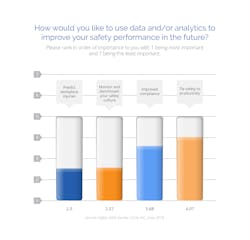According to behavioral researchers at Cardiff University, “It is widely accepted that human factors are the main contributory factor in accidents. This human element, of course, extends beyond those personally involved in an incident. It also incorporates all those who influence safety in that workplace, whether directly, consciously and immediately, or indirectly, unintentionally and perhaps with an extended time lag.”
For decades, workplace injuries and fatalities have been primarily assigned to human error. Fair or unfair, right or wrong, this result is largely due to the subjective nature of root cause analyses and a lack of data to demonstrate the incident occurred for other reasons. Today, safety professionals have more data at their fingertips than ever before, which means they need the tools to leverage it, so they can accurately identify root causes, trends in the data, and, most importantly, take proactive measures that drive safety performance.
Improving your organization’s safety performance is a team effort based on a quantifiable number of metrics that can be monitored and measured to prioritize and understand where your safety programs will have the most impact. It is confirming or discovering which situations and human factors could elevate risk to the worker.
When it comes to improving safety performance, the most important asset you can lean on is the data within your organization. In fact, a recent study asked EHS managers how they would like to use data and/or analytics to improve their safety performance in the future (see Figure 1). Respondents cited the most important reasons were to:
1. Predict workplace injuries
2. Monitor and benchmark their safety culture
3. Improve their compliance
4. Tie safety to productivity.
Where to Start
If you’re like most organizations, you have two immediate challenges:
● Identifying and collecting all the unused and untapped data within your organization—think metadata.
● Ensuring that the data you’re using to develop your safety performance score on is “clean”—this includes ensuring your data is complete (all relevant fields are entered) and accurate (the information in the fields makes sense).
As with any new project, it’s important to crawl before you walk and walk before you run. Whether your organization is in its infancy or has mature processes in place, there is a roadmap from simplified reporting to future perspective analysis.
There are a number of data analytics solutions and business intelligence offerings on the market that will allow you to visualize the safety outcomes and potential safety issues in ways that are easy to understand and identify. From there, you can do the hard work, which is embedding safety into your company’s core values. Leveraging these tools will enable you to identify risks so that you can plan targeted interventions and correctly allocate your safety spend. These outcomes can then be used to drive operational efficiencies and allow for more precision when asking questions about your business.
When you look to take your data and transform it into a model, it’s important to integrate information to gain a 360-degree view of safety processes. This can include additional enterprise data from ERP systems, equipment maintenance systems as well as third-party information from weather reports, geospatial information from imagery, etc. From there, you can use predictive modeling to compare data between leading versus lagging indicators to allow for better outcomes.
According to LNS Research, the evolution of interpreting EHS data includes:
● A descriptive context in which data can be used to tell what happened.
● A diagnostic tool which can explain why something happened (by looking at leading and lagging indicators).
● Predictive analytics can be used to manipulate variables that can be used to test the hypothesis of what will happen.
● Being able to use the information in a prescriptive manner. This will then provide tactical direction on which actions to take to prevent an injury or incident.
With any successful program, the foundation for change needs to occur in the intersection between where people, processes and technology come together. And, with any project, it is a fine balance in determining the correct measures and efforts required to get it right. In this topic, we are looking at the technology and information it collects while getting usage and adoption right.
Safety Culture is the People Component of Operational Excellence
As we have seen, safety culture is directly related to safety performance. It’s not separate from overall organizational culture, and it is not a policy, program, or procedure. We can define safety culture as the shared basic values, attitudes, motivations and knowledge that affect the extent to which safety is emphasized over competing organizational priorities.
Below are several examples of safety performance and safety culture metrics. See if you can spot the differences and how these might play into building and sustaining a strong safety culture within your organization:
Safety Performance
● Number of reportable incidents
● Number of audit findings
● Lost-time injuries
● Repeat offenders/offenses
Safety Culture
● Number of senior leadership safety visits
● Number of safety meetings and attendance rates
● Number of safety tours and observations
In addition, you may wish to track the following KPIs and metrics:
● Measures of responsiveness—how many days it takes to close an incident
● Staff qualifications, including total number of safety hours of training, credential modeling, etc.
By putting these together, you can model and determine the leading indicators impacting workplace safety at your organization.
An immediate indicator that your organization can use to gain a snapshot of your organization’s overall performance is the safety climate. According to Government of Queensland, “Safety climate is the perceived value placed on safety in an organization at a particular point in time.” It is the starting point for your overall safety culture strategy. In order to develop a measure of safety climate in your workplace, you have to look at metrics that make sense for your sector and organizational priorities.
Safety culture can be hard to measure, but it is more stable than safety climate over time. This is in part due to the growing volume and speed of data being generated within the enterprise. The goal is to measure safety climate change that predicts safety culture change in the workplace. It generally focuses on three areas:
● Management commitment
● Employee engagement
● Safety management systems.
Management Commitment
We look at these as leading indicators that can be measured towards prevention of incidents in the workplace. Culture comes from the top down and would be reflected in metrics that account for management commitment. In general, a best practice is to dedicate 60% of the KPIs to this function. Management commitment can include: financial investment, tools such as wearables, amount of team members committed to EHS, as well as their time allotted to it.
Some data points to consider are:
● Requested vs. actual budget
● Safety budget per unit produced
● Preventive spend
● Funding for tools to carry the safety program
● Marketing support for safety programs
● Capital projects to address high-risk safety issues
● Man-hours spent on safety prevention
● Current vs. ideal staffing
● Personnel SME training hours.
Employee Engagement
Employee engagement measures the effectiveness of the other two components. It can include items such as training competency, numbers of observations/suggestions, and voluntary participation in safety and related programs and committees. Employee engagements should weight at least 30% of the KPIs.
Some data points to consider are:
● Ratio of man-hours trained to worked hours
● Pass rate of training competency evaluations (on-the-job preferred)
● Training effectiveness results of training feedback surveys
● Number of observations
● Number of suggestions
● Employee man-hours spent on safety committees
● Breakdown of man-hours spent in safety committees
● Percent of employees that consider that they are in-charge of their safety
● Percent of employee suggestions adopted by management
● OSCAR survey.
Safety Management Systems
Safety management systems are an important component but can be challenging to measure. It’s important that you are able to find objective ways to measure the effectiveness of your programs, like CAPA/action tracking, root cause analyses, JSA/JHA programs for high-risk tasks as defined by operations and safety.
Some metrics to consider are:
● Inspections scores
● Audit scores
● Open actions
● Percent of action completion
● RCA & breakdown
● Percent of JSA/JHA completed/reviewed for high-risk activities
● Percent of safety procedures reviewed
● Percent of procedures available vs. procedures needed
● Ratio of preventive actions vs. corrective actions
● Completion of monthly regulatory reviews.
This component should weight to 10% of the KPIs. This weighting is due to the assumption we make that being “in compliance” is a need and should not affect safety culture dramatically.
Where Can You Mine the Best Data?
When it comes to leveraging your data, the most important and impactful source can be from your root cause analysis reports. As an EHS professional, being able to differentiate the root cause from the various intermediate issues that may arise during its analysis is critical. The root cause analysis will allow you to leverage the information captured, which can then be implemented into a top-down accountability structure that assigns and measures information, including goals and targets. At this point, the EHS manager can also go a level deeper to look into the processes required to make these changes.
Be prepared to ask and find answers to the tough questions. Key questions you’ll need to find answers to include:
● What are the main drivers of incidents in our organization?
● What can we do to change?
● How does changing the weighting of certain variables impact the organization’s performance?
The decision-making and reporting processes can be driven around practical targets for outcomes that are readily shared in multiple digital mediums (e-mail, dashboards, smart devices). These outcomes can impact your operations—from small things like scheduling maintenance schedules to large operational changes.
Bringing It All Together
A way to provide a mid-way to measure safety climate is to create a scorecard, which is a compilation of various user-defined metrics which together help evaluate the health of the main components of your company’s safety objectives.
When it comes to considering your baseline safety culture score (or metrics), it is important to consider the following:
● Test measure validity
● Data quality
● Don’t introduce change
● Test validity
● Record in DB.
You can start by defining a target for each measure and then use this to create a score. The culture score should be based on the measures selected is “100%” and climate measures how close you are from that ideal state. You can put these together in a management dashboard found within your EHSQ application. We can also say that once it’s implemented and operational, the safety professional is able to introduce one change at a time with a goal to affect culture by a particular amount. You would then be able to measure your success using climate/culture scores.
Since safety culture and safety performance have a critical impact on your operations, it’s time to start today. In terms of next steps, begin with data that is available to you. As much as possible, ensure the data is clean by applying relevant data hygiene practices. Define a safety culture index that allows you to first create a baseline score and then introduce changes to provide the impact to the program. From there, review and adjust to understand priorities and changes.
Mauri Paz, PE, PMP, CSP is manager of EHS products with Cority, a provider of EHSQ software solutions. With over 15 years of experience in the field of EHS and EMIS software design and implementation management, he has developed and implemented EMS systems, consulted for Fortune 1000 companies in matters of EHS, and implemented EMIS platforms for several Fortune 1000 clients.











